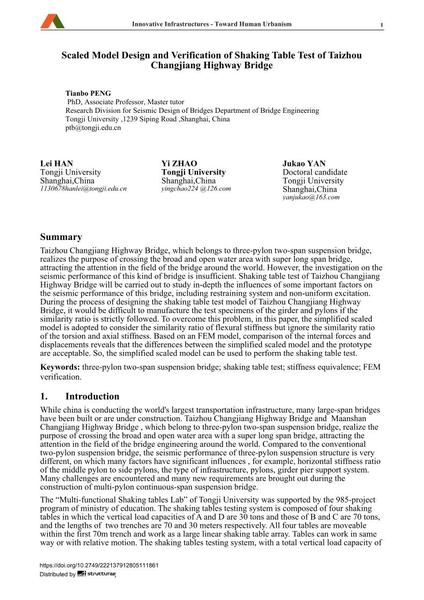Scaled Model Design and Verification of Shaking Table Test of Taizhou Changjiang Highway Bridge

|
|
|||||||||||
Détails bibliographiques
| Auteur(s): |
Tianbo Peng
Lei Han Yi Zhao Jukao Yan |
||||
|---|---|---|---|---|---|
| Médium: | papier de conférence | ||||
| Langue(s): | anglais | ||||
| Conférence: | 18th IABSE Congress: Innovative Infrastructures – Towards Human Urbanism, Seoul, Korea, 19-21 September 2012 | ||||
| Publié dans: | IABSE Congress Seoul 2012 | ||||
|
|||||
| Page(s): | 1371-1379 | ||||
| Nombre total de pages (du PDF): | 9 | ||||
| DOI: | 10.2749/222137912805111861 | ||||
| Abstrait: |
Taizhou Changjiang Highway Bridge, which belongs to three-pylon two-span suspension bridge, realizes the purpose of crossing the broad and open water area with super long span bridge, attracting the attention in the field of the bridge around the world. However, the investigation on the seismic performance of this kind of bridge is insufficient. Shaking table test of Taizhou Changjiang Highway Bridge will be carried out to study in-depth the influences of some important factors on the seismic performance of this bridge, including restraining system and non-uniform excitation. During the process of designing the shaking table test model of Taizhou Changjiang Highway Bridge, it would be difficult to manufacture the test specimens of the girder and pylons if the similarity ratio is strictly followed. To overcome this problem, in this paper, the simplified scaled model is adopted to consider the similarity ratio of flexural stiffness but ignore the similarity ratio of the torsion and axial stiffness. Based on an FEM model, comparison of the internal forces and displacements reveals that the differences between the simplified scaled model and the prototype are acceptable. So, the simplified scaled model can be used to perform the shaking table test. |
||||

